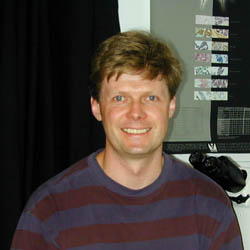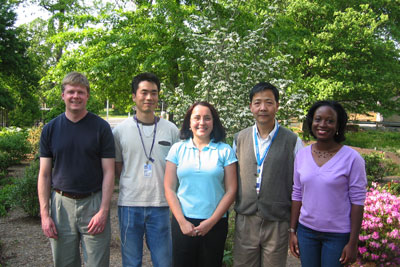|
|
 |
Back to Previous Page Previous Page
Neuronal Migration Disorders Unit

Brian Howell, Ph.D., Investigator
Dr. Howell received his Ph.D. degree from McGill University in 1992. During his post-doctoral work with Dr. Jonathan Cooper at the Fred Hutchinson Cancer Research Center in Seattle, he worked to identify novel signaling molecules required for brain development. The targeted disruption of one of these genes, mouse disabled, revealed a role for this molecule in neuronal positioning. Dr. Howell moved to the NINDS in 1999 and his laboratory is interested in the developmental events that regulate structure formation in the brain.
Staff:

Research Interests:
Work in our laboratory is focused upon the identification of molecular controls of neuronal migration. During development, neurons disperse from the neural tube to occupy discrete regions of the central nervous system. The mechanisms that regulate this process are not fully understood; however recent work from a number of groups including ours has defined 3 components of a signal transduction pathway that determines the final position of neurons in laminated structures of the brain such as the cerebellum, hippocampus and cerebral cortex. Neurons are misplaced in mice that don’t produce the secreted molecule Reln, the LDL-receptor like proteins VLDLR and APOER2 or the intracellular docking protein Disabled 1 (Dab1).
Genetic and biochemical experiments suggest that when a migrating neuron is exposed to Reln this leads to signal propagation that requires the
intracellular Dab1 protein. The ApoER2 and VLDLR membrane spanning proteins likely act to relay the Reln signal to Dab1. These receptor molecules bind Reln on their extracellular domains and Dab1 to their intracellular tails. In addition, when neurons are treated with Reln, the Dab1 docking protein becomes tyrosine phosphorylated and this phosphorylation is dependent upon Reln binding to the receptors.
Current work is focused on the downstream consequences of Reln signaling. By genetic targeting we are generating mice that
produce only mutant Dab1 molecules that cannot be tyrosine phosphorylated. If Dab1 phosphorylation is an essential signal as a
neuron migrates into a Reln rich layer, then these mice are predicted to have a phenotype similar to the Dab1 null mice.
Protein-protein interactions, which are dependent upon Dab1 tyrosine phosphorylation, are also of interest if this is the critical
modification that relays the positional signal. The cell biological consequences of Reln action upon migrating neurons are also
being investigated.
 |  |
Selected Publications:
- Pramatarova, A., Chen, K-L., Howell, B.W. (2008) A genetic interaction between the APP and Dab1 influences brain development., Mol. Cell. Neuosci. 37, 178-186. Full Text/Abstract
- Matsuki, T., Pramatarova, A., Howell, B. (2008) Reduction of Crk and CrkL expression blocks Reelin-induced dendritogenesis, J. Cell Sci 121, 1869-1875.
- Andrade, N., Komnenovic, V., Blake, S., Jossin, J., Howell, B., Goffinet, A., Schneider, W.J., Nimpf, J. (2007) ApoER2/ VLDL receptor and Dab1 in the rostral migratory stream function in postnatal neuronal migration independently of Reelin., Proc. Natl. Acad. Sci. 104, 8508-8513.
- Pramatarova, A., Ochalski, P.G., Lee, C-H., Howell, B.W. (2006) Mouse Disabled 1 regulates the nuclear position of neurons in a Drosophila eye model. , Mol. Cell. Biol. 26, 1510-1517. Full Text/Abstract
- Hoe, H-S, Tran, T.S., Matsuoka, Y., Howell, B.W., Rebeck, G.W. (2006) Dab1 and Reelin effects on APP and ApoER2 trafficking and processing, J. Biol. Chem. 281, 35176-35185. Full Text/Abstract
- Verbeek, D.S., Knight, M.A., Harmison G.G., Fischbeck K.H., and Howell, B.W. (2005) Protein kinase C gamma mutations in spinocerebellar ataxia 14 increase kinase activity and alter membrane targeting., Brain 128, 436-442. Full Text/Abstract
- Chen, K., Ochalski, P.G. Tran, T.S. Sahir, N. Schubert, M., Pramatarova, A. and Howell, B.W. (2004) Interaction between Dab1 and CrkII is promoted by Reelin signaling., J. Cell Sci. 117, 4527-4536. Full Text/Abstract
All Selected Publications
Contact Information:
Dr. Brian Howell
Neurogenetics Branch, NINDS
Porter Neuroscience Research Center
Building 35, Room 2A-116
35 Covent Drive, MSC 3705
Bethesda, MD 20892-3705
Telephone: 301-435-1835 office,
301-435-1835 laboratory,
301-480-3365 fax
Email: howellb@ninds.nih.gov
|

